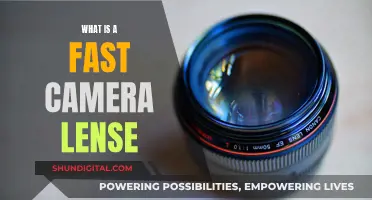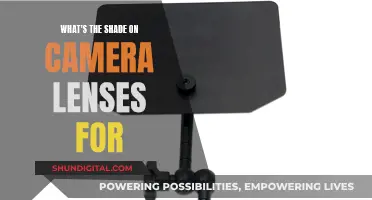
Camera lenses are fragile and expensive, so it's important to store them properly to protect your investment and keep them in good working order. While purpose-built lens cases are ideal, there are other ways to safely store your camera lenses without one.
The biggest dangers to camera lenses are blunt force, humidity, dust, and changes in temperature. To protect your lenses from these threats, it's important to control the environment in which they're stored. Keep them in a dry, airtight space, away from extreme hot or cold temperatures.
If you don't have a lens case, there are still steps you can take to protect your lenses. Store them front-element-side-down to minimise oil in the aperture blades, and close the aperture rings to the smallest f-stop to reduce tension on the springs. Keep them in a separate compartment, and always put the lens cap on for extra protection.
What You'll Learn

Store them front-element-side-down
Storing your camera lenses front-element-side-down is a good idea, especially if you're using older lenses. Modern autofocus lenses use less oil in their manufacturing, but it's still better to be safe than sorry.
Storing your lenses this way will minimise the presence of oil in the aperture blades. If oil gets into the aperture blades, it can really gum up the works when you try to change the aperture in the future.
If you're using older lenses, you might find that oil can build up on the aperture blades over time. This can cause problems when you try to change the aperture, as the oil will make the blades sticky and difficult to move. By storing your lenses front-element-side-down, you can help to prevent this issue.
In addition to minimising oil build-up, storing your lenses front-element-side-down can also help to reduce tension on the springs in the lens. The springs in your lenses, like any other springs, will fatigue over time. By storing the lenses with the aperture set to the smallest f-stop, you can reduce the tension on the springs and help to prolong their life.
Overall, storing your camera lenses front-element-side-down is a good practice to keep them in good condition, especially if you're using older lenses. It's a simple step that can help to prevent issues with oil and tension on the springs, so it's worth making it a habit when you're putting away your camera equipment.
Understanding Camera Lenses: Power of Convergence and Divergence
You may want to see also

Keep them in a dry cabinet
Dry cabinets are a great way to store your camera lenses without a case. They are a cost-effective solution, often cheaper than a single lens or body, and are an essential purchase for the serious photographer.
Dry cabinets are storage units that regulate humidity levels to keep the contents dry. They are the best solution for storing lenses for extended periods, as they prevent mildew, rust, mould, fungus, rust, and even insects. They also prevent dust and dirt from accumulating on your gear, reducing the amount of time needed to clean your lenses and camera.
When choosing a dry cabinet, consider the number and size of lenses you need to store. Dry cabinets come in various sizes, with adjustable shelves to customise the space. For example, the Slinger Electronic Dry Cabinet comes in 35L, 90L, and 300L capacities, accommodating three to eight lenses and a camera body.
Additionally, dry cabinets can have features like LED lights and lockable doors for added security. Some models, like the T.A.P. LED Digital Display Electronic Automatic Dry Cabinet, even have an LED light inside to help you see your equipment clearly.
Overall, dry cabinets are an excellent option for storing your camera lenses without a case, offering protection from humidity, dust, and other environmental factors that could damage your valuable equipment.
Welding and Cameras: Can Welding Damage Camera Lenses?
You may want to see also

Protect them from blunt force
Protect Your Camera Lenses from Blunt Force
Camera lenses are delicate pieces of equipment that can be easily damaged by blunt force, such as dropping or knocking them against something. Here are some tips to protect your lenses from physical damage:
- Invest in a protective camera bag: A good camera bag will help cushion your lenses against impacts and protect them from being dropped. Look for bags with padded walls and adjustable dividers to keep your lenses secure.
- Use a neck or hand strap: A strap can help prevent drops by securing your camera to your body.
- Hard-shell lens case: A hard-shell lens case provides a tough exterior to protect your lenses if they get knocked around during travel. Look for one with a lock combination to prevent theft and ensure it's water-resistant and dirt-proof.
- Soft lens case: A soft lens case made of nylon or other waterproof material will protect your lenses from moisture and dust. It should have a padded interior and a loop or shoulder strap for easy carrying.
- Pouch: A pouch is similar to a soft lens case but less firm and structured. It closes with a drawstring, making it a bit less convenient to handle while holding a camera. However, it offers the same protection as other cases and can clip onto your bag with a hook.
- Dry cabinet: A dry cabinet is a storage unit that regulates humidity levels to prevent mildew, rust, mold, and other damage caused by moisture. Look for one with adjustable shelves and LED lights.
- Screen protector: Install a screen protector on your camera's LCD screen to safeguard it from scratches, fingerprints, and other types of damage.
- Rain cover: Use a rain cover when shooting in wet weather to protect your camera and lenses from water damage.
- Hard case: A solid hard case offers protection from physical damage and the elements, keeping your equipment safe from harm.
Squaretrade Coverage for Camera Lenses: What You Need to Know
You may want to see also

Avoid leather lens cases
While leather is a great material for gadget bags, backpacks, straps, and shoes, it is not ideal for storing camera lenses. Leather lens cases can cause more harm than good. Here's why you should avoid them:
Leather Retains Moisture
Leather is a natural material that can absorb and retain moisture. This creates an ideal environment for the growth of mould and fungus, which can damage your lenses over time. The high humidity can also cause condensation inside the lens, leading to blurred images and, in severe cases, permanent damage.
Microbes Thrive in Leather
The warm and moist conditions created by leather cases provide the perfect breeding ground for microbes such as bacteria and fungi. These microbes can cause further damage to your lenses, affecting their performance and reducing their lifespan.
Leather Cases are Hard to Clean
The plush fabric lining found in some leather cases can harbour dirt and grit over time. This can lead to abrasion and scratching of the shiny lens barrels, reducing the image quality and requiring costly repairs.
Leather Cases Offer Limited Protection
Leather cases may not provide sufficient protection against physical damage. If dropped or knocked, the impact can easily transfer to the lens inside, potentially causing cracks or other damage.
Alternative Options
Instead of leather cases, opt for nylon or PU (polyurethane) lens cases. These materials offer better resistance to abrasion and discolouration. Additionally, consider using dry cabinets or desiccants to regulate humidity and prevent moisture-induced damage.
Final Thoughts
While leather lens cases may look stylish, they can be detrimental to the health of your camera lenses. By avoiding leather cases and following proper lens storage practices, you can ensure the longevity and optimal performance of your photography equipment.
Cleaning Camera Lenses: Mars Exploration Tips
You may want to see also

Use silica gel
Silica gel is a great option to protect your camera lenses from moisture when storing them without a case. Here are some tips on how to use silica gel effectively:
Use the Right Amount of Silica Gel
It is important to use an adequate amount of silica gel, especially in sealed containers, to ensure effective moisture protection. The amount of silica gel you need will depend on the size of the container and the number of lenses you are storing. For small containers, very small silica gel sachets, such as 5-gram packets, may be sufficient. However, it is generally recommended to overestimate the amount and size of silica gel sachets to guarantee adequate moisture protection.
To maximise the effectiveness of silica gel, it is best to store your lenses in a container made of insulating material, such as plastic, glass, or metal. Plastic containers with tight-fitting lids are ideal for keeping the relative humidity low. Glass jars with spring caps and rubber seals, similar to those used for canning or food storage, are also excellent options for storing camera lenses.
Monitor the Performance of Silica Gel
When using silica gel, it is a good idea to monitor its performance, especially during the initial period. Weigh the containers with the lenses and silica gel sachets to track their moisture absorption. This will help you intercept the sachets before they become fully saturated and replace or regenerate them as needed.
Use New or Properly Regenerated Silica Gel
It is important to use new or properly regenerated silica gel sachets. Silica gel has a saturation point, and once it reaches this point, it will no longer be effective in absorbing moisture. To regenerate silica gel sachets, you can dry them in an oven or microwave. Weigh the sachets before use to ensure they are not already fully saturated, as they should be approximately 20% more than their original weight.
In addition to long-term storage, silica gel can be useful when dealing with special climatic conditions or sudden temperature changes that may cause condensation issues. Place your camera lenses in a bag with unsaturated silica gel sachets and seal it for a while to allow the silica gel to absorb any condensate formed due to the temperature change.
Clean Your Phone Camera Lens Scratch-Free
You may want to see also
Frequently asked questions
There are several ways to protect your camera lenses from damage. Firstly, always use a lens cap to protect the lens from dust and scratches. Additionally, store your lenses in a dry place to prevent humidity, which can cause condensation and damage the lens elements. Furthermore, use a camera bag with padded walls and adjustable dividers to keep your lenses safe and secure during travel.
Alternative storage solutions for camera lenses include dry cabinets, Pelican cases, and tool chests. Dry cabinets help regulate humidity levels and protect your lenses from mildew and rust. Pelican cases offer excellent protection against physical damage and environmental factors, while tool chests provide a secure storage option with thinner pull-out shelves for organising smaller accessories.
When storing camera lenses at home, it is important to keep them in a safe and secure place, away from direct sunlight, extreme temperatures, and electronic items that emit magnetic fields. Additionally, consider using a screen protector to safeguard the LCD screen from scratches and a lens filter to provide extra protection in case of accidental drops. Lastly, always remove the camera battery and memory cards when storing your gear for extended periods.







